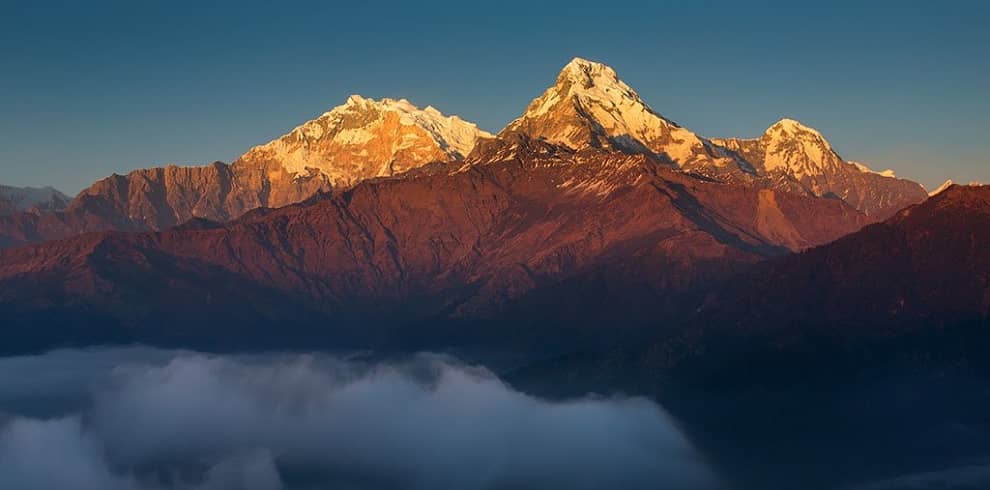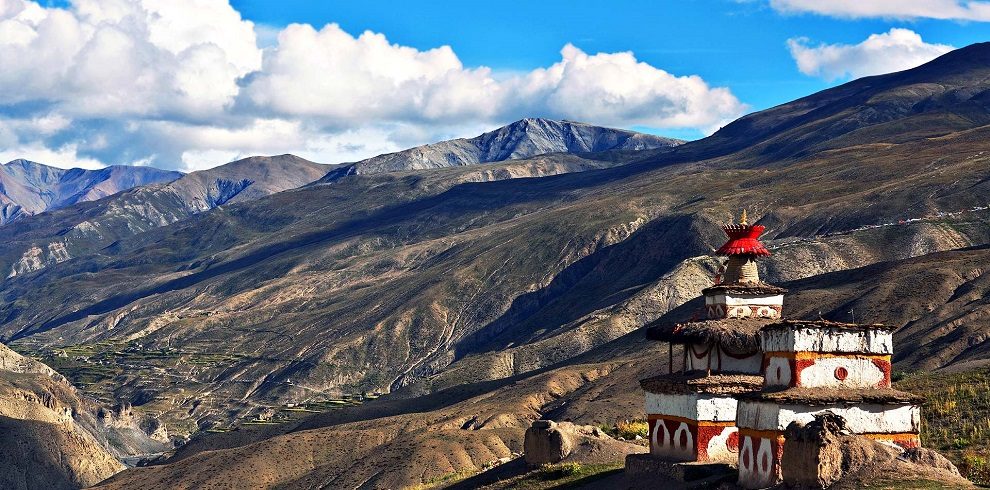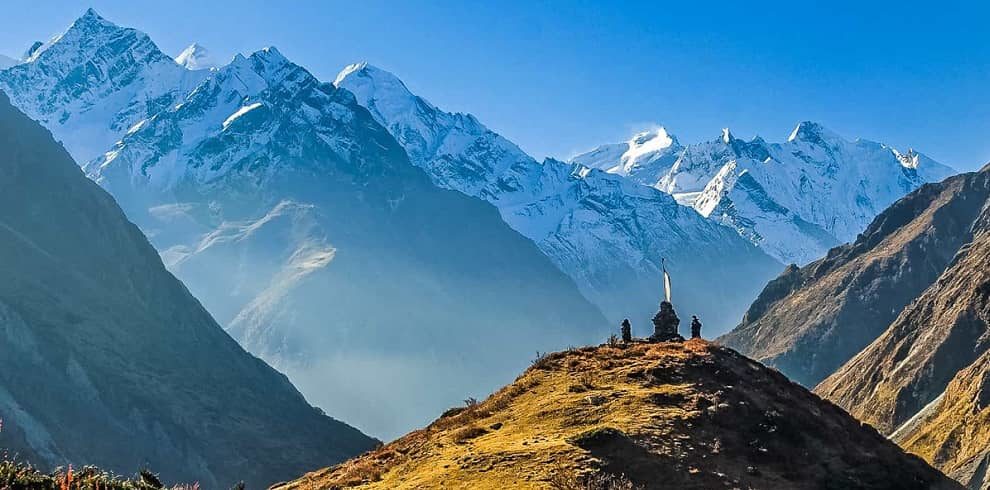Introduction To Ghorepani Poon Hill Trek In Nepal
Ghorepani Poon Hill Trek takes you through stunning mountain landscapes, quaint Gurung villages, dense rhododendron woods, and sub-tropical valleys in the Annapurna region, with the spectacular Machapuchare (Fish Tail Peak) dominating the skyline.
Sunrise views of the Annapurna massif, Dhaulagiri, Nilgiri, Hiunchuli, and Machhapuchhre can be had from the top of Poon Hill (3,210m / 10,531ft), which is located above Ghorepani Village (6,993m).
This walk allows you to immerse yourself in nature, beauty, and unique culture in one of the most gorgeous locations on the planet.
A drive from Pokhara to Ulleri via Tikhedhunga is usually the first leg of this itinerary. However, a day before departing from Pokhara, we arrange a complimentary journey from Kathmandu to Pokhara on a tourist bus. We travel to Ghorepani after arriving in Tikhedhunga.
Along the route, you’ll have the opportunity to visit local communities and interact with the locals to gain a better understanding of their lives and cultures. This trek also offers spectacular vistas of the Annapurnas, Machhapuchhare, and Hiunchuli, as well as Dhaulagiri, our first summit. We’ll keep hiking till we reach Ghorepani, which is our target for the day.
We travel to Poon Hill early the next morning to witness the spectacular sunrise over the snowcapped Himalayas. Hiunchuli, Annapurna South to Annapurna I (8,097m / 26,566ft), Gangapurna, Khangsar Kang, Annapurna III, Dhaulagiri (8,167m / 26,795ft), and Machhapuchhare are just a few of the mountains visible from Poon Hill.
Because of the spectacular views from Poon Hill, it is a favored place for many photographers. We’ll also spend some time at Poon Hill taking in the natural splendor and taking photos to our hearts’ content.
We resume our journey to Tadapani after returning from Poon Hill. We’ll take the trail that leads us through the rhododendron groves. When you arrive in Tadapani, you will notice that this settlement also offers a view of the massive Annapurna Mountains.
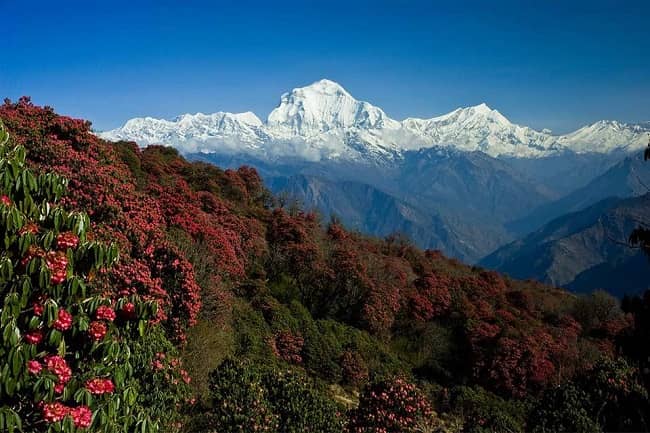
Our third day of trekking takes us from Tadapani to Jhinu Danda. You’ll be strolling through rhododendron, bamboo, and oak tree forests once again. You will pass through Chomrong, a quiet settlement, on your way to Jhinu Danda. There are hot springs near Jhinu Danda, so we’ll take our time and relax in them.
On the trek itinerary, the fourth day is your final day. We’ll wake up at Jhinu Danda and begin our trip to Siwa/Ghandruk Phedi. We return to Pokhara from Ghandruk Phedi along a scenic route across the countryside.
We take a bus from Pokhara to Kathmandu the next morning. Your journey is now complete, and we hope you have made memories to cherish for the rest of your life.
This plan includes a 6-7-hour tourist bus travel from Kathmandu to Pokhara, but you can upgrade to a 20-minute flight from Kathmandu to Pokhara for an additional fee. For the trip briefing, we ask that our clients arrive in Kathmandu before 3 p.m., one day before the trip departure date. We go over everything you’ll need in the trek zones and set your trip expectations at the trip briefing.
Highlights Of Everest Base Camp Hike/Tour In Nepal
- Pokhara is Nepal’s tourist capital.
- From Poon Hill, you may get a panoramic view of the mountains (3210m) Ghorepani Village View Tower
- Jhinu Danda’s hot springs
- This is a short hike that is suited for people of all ages.
- There’s no need to worry about altitude sickness or acute mountain sickness on this easy hike.
- Ghandrung has lovely villages and fields.
- A glimpse into Nepalese rural life
Benefits Of Everest Base Camp Hike/Tour In Nepal
- Free transportation to and from Tribhuvan International Airport from your Kathmandu hotel (TIA)
- During the walk, there is no charge for extra luggage storage.
- At high altitudes, oximeters are used to measure blood oxygen saturation in order to detect early signs of altitude sickness and other health hazards.
- First-aid kit
- If you don’t have your own sleeping bags or down jackets, we can help you set them up.
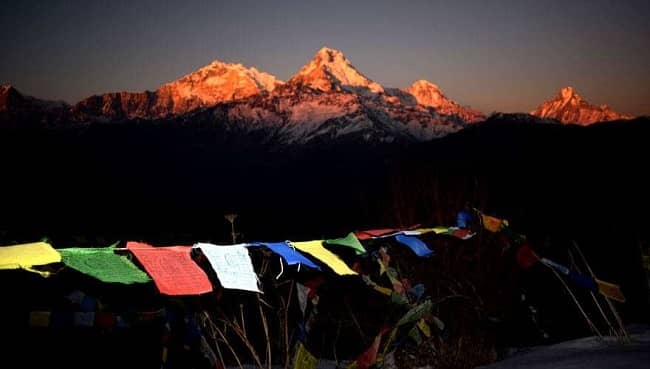
Poon Hill Trek Gear
The specific clothing and equipment you’ll need for the Poon Hill trek can vary depending on the season, but here’s a list of items to keep in mind. We also ask that you just bring what you absolutely need.
Head
- Scarf or hat for the sun
- Winter hat, insulating hat, or a hat with a wide brim
- Extra batteries for the headlight
Face
- Sunscreen
- Sunglasses that block UV rays
- Wipes for the face and body
Hands
-
Lightweight gloves
-
Heavyweight winter gloves
Body
- Shirts for hiking
- Shirt with a long sleeve made of synthetic fiber.
- Rain jacket with hood
- Jacket made of fleece
- Cotton pants that are light and airy.
- T-shirt (bring lightweight wool)
- Underwear made of polypropylene
- Jacket with down feathers (available for rent in Kathmandu)
- Sweater
- Jacket and pants that are waterproof
Footwear
- Boots for Hiking
- Socks made of thick wool (Take an extra pair of thick light socks)
Essential gear
- A daypack or a backpack (Size depends on whether you take a porter or not)
- Bottle with a heating element
- Purification of water
- Pole for hiking
- Bag for sleeping (-15 degree bag is best for high altitude trekking)
Toiletries
- a drying towel of medium size
- Toothbrush
- Toothpaste
- Deodorant/floss/toilet paper
- Biodegradable soap in a bar
- a pair of nail clippers
- Mirror, little
Personal accessories
-
Money
-
Watch
-
Cell phone
-
Camera
Extra items
- Kit for first aid
- Extra passport pictures and passport photocopies
- Pencil and notebook
- Binoculars
Poon Hill Trekking Difficulty, Cost, Best Time & Info
Poon Hill Trip package | Complimentary Airport Transfer
On your arrival, we will pick you up from the airport and drop you off at your hotel in a private vehicle, and vice versa on your departure. Our agent will be holding a booklet with your name on it at the Tribhuvan International Airport. As a welcoming gesture, they will either give you a Khada or Marigold garland and then drive you to your accommodation. To take use of this free service, please provide your flight information.
Poon Hill Accommodation | Lodge & Tea House
Three nights in the best lodges in the trekking districts and two nights in a Pokhara hotel are included in the Poon Hill Trek. At Ghorepani and Jhinu Danda, you’ll spend two nights in twin sharing rooms with connected bathrooms, and one night in a twin sharing a basic room at Tadapani.
In Pokhara, you will spend two nights in a hotel. The accommodation has a private bathroom, TV, 24-hour hot water, electricity, and a laundry facility.
Wherever possible, solo trekkers will be accommodated in a single private room with an attached bathroom, and in a single private room otherwise.
Before and after the trek, two nights in a hotel in Kathmandu may be required, however, this is not included in the package. There are hotels in Kathmandu to suit all budgets and inclinations.
For an additional fee, lodges/hotels provide hot showers and Wi-Fi.
The Meals during Poon Hill Trek Route
Because the Ghorepani Poon Hill Hike takes you to high altitudes in the Annapurna region, you’ll need to eat well. We will provide you with excellent and healthful food, but you will not have as many options as you would in a city.
During the walk, we will supply you with 5 breakfasts, 4 lunches, and 3 evenings.
The following are some of the most popular menu items:
Oatmeal, Corn Flakes, French toast with jam, butter, and cheese, Honey Tibetan bread or Chapati, and local Tsampa porridge are the five breakfast options. Fruits, Vegetables, Eggs, Pancakes, Muesli Breads Drinks that are heated (varieties of teas and coffees, hot chocolates, etc.)
Dhal, Bhat, Tarkari, Tibetan Bread, Soups, Momo (dumplings), Macaroni meals, Tenduk Spaghetti Noodles, Thukpa, Pasta, Vegetable curry, Potatoes, Vegetables, Salad Pizza (Tomato, Mushroom, Mixed), Snacks (Papad, Prawn), Desserts (Rice Pudding, Apple Pie), etc.
Three dinners – Dhal, Bhat, Tarkari, Tibetan Bread, Soups, Sherpa Stew, Steaks, Sandwiches, Momo (dumplings), Macaroni, Tenduk Spaghetti, Noodles Thukpa, Pasta, Vegetable curry, Potato items, Vegetable and salad Pizza (Tomato, Mushroom, Mixed), Snacks (Papad, Prawn), Korean Raman, Desserts (Rice
We handpick the top tea houses/lodges that serve delicious, sanitary, and nutritional food. Traditional, Asian, and western cuisines are available on the menu. However, as we progress higher in the mountain, the menu becomes increasingly limited.
At high altitudes, we strongly advise you to consume fresh vegetables and liquids (green tea, lemon tea, hot lemon, garlic soup (must), and ginger tea).
Though there will be lots of non-vegetarian options available in the trekking zones, we do not advocate them because the meat may not be hygienic. We also recommend avoiding alcohol, caffeinated beverages, hot chocolates, and dairy products.
This package does not include lunch or dinner in Pokhara.
All personal costs (alcoholic drinks, hot (tea, coffee), and cold drinks) in tea houses/ Lodges/cafés are excluded from the program, save for standard meals (breakfast, lunch, and dinner with seasonal fruits).
Best Time For Poon hill trek
Poon Hill is best visited in the spring (March-May) and autumn (September-November) (September – November). The skies are clear and the vistas are spectacular during this time.
People, on the other hand, trek to Ghorepani and Poon Hill all year, and we offer Poon Hill treks in all seasons.
The walk becomes difficult in the winter due to the cold temperatures and snowfall, while the monsoon rains make the routes wet and slick in the summer. These obstacles appeal to some daring trekkers, who hike to Ghorepani and Poon Hill during these seasons as well.
The temperature in the mountains is also affected by altitude; the higher you go, the colder it becomes. The weather in the high altitudes of the Ghorepani Poon Hill hike is as follows.
March-May (spring)
Spring (March-May) is the best time to visit Poon Hill and trekkers from all over the world flock to the area at this period. The weather is pleasant, the rainfall is light, and the trekking conditions are ideal during this season.
In the Poon Hill high elevations, daily spring temperatures range from 5°C to 15°C. It is warmer in the lower parts. After March, the trekking season begins, and by April, the walking path goes through rhododendron flower blossoms, which brighten the sub-tropical jungle with red, pink, and white hues.
June – August (summer)
Your trek to Poon Hill will be in the summer if you go between July and August. While summer temperatures in the hiking regions are hot, it is also monsoon season, which means there is a lot of rain. The trekking trails may be damp and slick due to rain.
The monsoon season usually starts at the end of June and lasts until the second week of August. During the summer, daytime temperatures at high altitudes ranging from 15°C to 25°C. The nights are cooler, with temperatures ranging from 5 to 15 degrees Celsius.
While rain may pose certain issues, it also offers much-needed water to plants, allowing them to flourish. This is the trekking season for you if you appreciate beautiful flora.
September – November (autumn)
Autumn is also a good time to go on the Poon Hill hike. Autumn trekking is enjoyable because of the moderate temperatures, light winds, and low precipitation.
The sun shines brilliantly, the sky is clear, and you have a spectacular view of the mountains throughout this season. The nights are also cloud-free, allowing you to enjoy spectacular vistas of the night sky.
The monsoons will have passed by early September, and the weather will be pleasant. In high altitudes, daytime temperatures can exceed 20°C. The nights are cooler, with lows of approximately 5°C.
The greens that bloomed during the monsoon fade to golden/amber throughout this season, creating a stunning contrast against the clear blue skies. The terraced fields’ grains are mature and ready to be harvested.
The lowlands are lush and the environment is clean.
This is when the two most important Nepali festivals, Dashain and Tihar, take place. This creates a celebratory atmosphere in the hiking regions and throughout Nepal.
December – February (winter)
The Annapurna region’s winter treks are not as popular as the region’s spring and autumn excursions. During the winter, the Ghorepani trek zones are cold, with snowfalls, yet this delights some trekkers.
From late December to early February, it is the coldest. The weather steadily warms in late February. At high altitudes, daytime temperatures can drop below -5 °C.
Winter skies are frequently exceptionally clear, despite the cold, and mountain views are at their best with snow crowns. During this season, the trails are the least crowded. While rookie hikers may find this route difficult, experienced hikers will have little trouble completing it in the winter.
The weather in the Himalayas is changeable and unpredictable.
Physical Condition & Experience Requirements
The Poonhill Hike in the Annapurna region is a moderately difficult trek. Hiking takes about 4 to 5 hours per day, with frequent breaks to savor and appreciate the breathtaking mountain vistas.
The Ghorepani trek routes are not particularly steep, but they do ascend and descend pretty steadily. Physically, trekking at higher altitudes is more difficult than trekking at lower altitudes. As a result, you’ll need to be physically fit and determined.
This trek can be completed by hikers who can hike for 4 to 5 hours per day at a fair pace while carrying a light day pack. It’s possible that some days will necessitate more waking hours.
Participants with pre-existing medical concerns including heart, lung, or blood disorders should let us know before signing up for the walk.
Trekking in Nepal | Group Trekking | Private & Single Treks
We organize both group and private treks. Group discounts are available dependent on the size of your group. The larger your group, the greater the savings. Please see our price list for further information. Simply click the – we offer group discounts – link on the right.
We can accommodate any size group. Each group will have a guide, and we will assign a porter to every two trekkers. We will provide an assistant guide for groups of 12 or more.
A typical Poon Hill Trek Day
A typical day on the Poon Hill climb includes spectacular landscape views, the opportunity to study and explore new sites, and opportunities to interact with local people and learn about their culture. You can also take photographs of the beautiful scenery.
Our knowledgeable and experienced guides and porters will provide you with information about the areas you will visit during the journey.
After breakfast, we start off on the day’s walk-in between 7 and 8 a.m., depending on the journey distance and type. You’ll have lunch at 12 and then take an hour off. We resume our journey after a brief respite. The majority of afternoon hikes will be short.
We’ll eat our snacks after we arrive at our destination for the day. You will have the opportunity to explore the villages/settlements/towns before it gets dark. Dinner will be served between 7 and 8 p.m.
We’ll socialize before retiring to bed. Your trek guide will brief you on the hiking plans for the following day. You can play games like cards or monopoly, read books, or watch climbing films after the journey briefing. The majority of our visitors prefer to learn common Nepali phrases from our staff.
Communication during the trek
For a fee, you can use the internet at lodges/tea houses during the Poon Hill Trek. We will, however, use the phone to communicate at high altitudes. At least once a day, we will communicate with hiking teams through the trek team leader.
You may receive signals at hiking regions depending on the type of network you use, but they may not be powerful enough. In Kathmandu, you can purchase a local sim card if desired.
Wi-Fi is accessible in tea houses and lodges, although there is a fee for it.
Battery recharge, water on the trek
Electricity for camera and cell battery recharge is offered at an additional cost throughout the lodges in the Poon Hill trekking districts.
Local lodges and en-route shops provide packed mineral water, or you can fill your water bottle with boiled water for an additional fee. We can offer you water purification pills if necessary.
In some locations, you should not consume water from rivers, taps, or wells because the water may not be safe to drink.
Extra personal expenses during the trek
All trekkers will require spending money for a variety of reasons. The cost of meals and lodging in Kathmandu is not included in our package. Additionally, all of our valued guests must carry personal spending money to cover visa applications, travel insurance policy purchases, beverages, trek snacks, hot (tea/coffee) and cold drinks, tips to trekking crew members, souvenirs, and other expenses.
We recommend bringing cash (major currencies) that can be easily exchanged for Nepalese rupees. Only Nepalese money is accepted in trekking areas.
Travel Insurance for Poon Hill Trek
Poon Hill Trek is a moderately difficult trek with no risk of high altitude sickness. However, due to the likelihood of unplanned or unexpected incidents such as accidents, illness, floods, landslides, or sudden climate changes, this mountain excursion is not a typical visit.
Travel insurance is required for the Poonhill Trek. We require a copy of every trekker’s complete travel insurance policy certificate. Medical and emergency repatriation must be covered, as well as helicopter rescue and evacuation costs at high altitudes.
Members of the trekking community are kindly asked to give their comprehensive insurance information once they have booked a trek. In the event of an emergency, we will rely on the documents you supplied us with for assistance. It will assist us in planning a rapid and efficient rescue effort, as well as a transfer for emergency medical assistance.
Please check with your insurance carrier to see if they cover helicopter evacuation and medical charges at the highest trek heights.
Passport and visa
Except for Indian nationals, all foreigners must have a valid visa to enter Nepal. At Tribhuvan International Airport and Nepal’s borders with India and Tibet, you can obtain an on-arrival visa. Visit www.immigration.gov.np. for additional details.
You’ll need a passport that’s valid for at least six months, a passport-size photo, and visa fees to apply for a visa. A 30-day visa costs $50 at the moment (to be paid in cash).
A free visa will be given to children under the age of ten. It is strongly recommended that you examine the current regulations. Visa regulations are subject to change at any time. Citizens of China and members of the South Asian Association for Regional Cooperation (SAARC) (Bangladesh, Bhutan, India, Maldives, Pakistan, and Sri Lanka) are exempt from visa fees.
Certain countries’ citizens may be denied a visa upon arrival. On-arrival visas are not available for citizens of Nigeria, Ghana, Zimbabwe, Swaziland, Cameroon, Somalia, Liberia, Ethiopia, Iraq, Palestine, and Afghanistan. If you are a citizen of one of these countries, please contact the Nepalese Embassy in your country.
Before we embark on our journey, we’ll double-check everything (luggage, equipment, etc.) during our briefing.
Money exchange
Nepali Rupees (NPR/Rs) are the local currency.
(1 USD = ~ Rs.124 NPR).
You can exchange major foreign currencies through local banks and legitimate money exchanges in Kathmandu and all over Thamel. Legitimate money exchanges display their ongoing exchange rates visibly to the public.
Please note – only 100 INR (Indian Rupees) and 2000 INR notes are legal in Nepal.
Despite having the security advantage of traveler’s cheques, we prefer cash exchange. It helps avoid lengthy processes and high bank commissions.
You can withdraw cash (in Rupees)from ATMs all over Kathmandu and Thamel itself. Many of these ATMs are open around the clock. The maximum withdrawal amount is 35,000 Rupees for a 500 Rupees processing fee for foreign cards.
If you use the money exchange facilities at banks and financial institutions, they impose a service charge fee of about 4% or more.
During the trek, there are no banks and money exchange services so you should exchange your money in Kathmandu, depending on how much personal expense you require. Only Nepali Rupee is accepted in trekking regions.
Most established banks in Asia will only accept foreign currency notes that are not old, torn, or faded. Please ensure that you have new, clean notes.
How much luggage can I take during Poon Hill Trek?
One porter will be assigned to every two trekkers. Porters are only allowed to carry a total of 18kg of luggage. As a result, a trekker’s luggage allowance is 9kg. We also want you to bring a small backpack with you that contains your valuables and important documents. Non-essentials can be left for free at the Discovery World Trekking store.
During the trip briefing, we’ll check over your luggage and equipment to make sure you have everything you need.
Poon Hill Trek Safety
We ensure the safety and security of our valued clientele. For us, the most important consideration is safety. Here are some of the ways we keep our excursions safe.
- We have all of the necessary equipment, as well as first-aid supplies.
- Our team has gone through comprehensive first-aid training.
- If someone becomes ill, the trek guide (leader) has the authority to continue or descend, keeping the trekking group’s best interests in mind.
- Our squad is made up of folks from the distant Himalayan highlands who have incredible stamina.
- We’ll go on a hike as a group.
- In the event of an emergency, a helicopter will be dispatched for rescue (funded by insurance)
Keeping Poon Hill Region Clean
By safeguarding our fragile ecosystem, we are devoted to environmental sustainability.
Without a question, tourism has had many positive effects in terms of income creation, job possibilities, infrastructure, healthcare, and education; yet, it has come at a cost: environmental damage.
We make every effort to perform eco-tourism in the trekking areas by leaving just our footprints. We collaborate with the Kathmandu Environmental Education Project (KEEP) to offer environmentally responsible tours that benefit both visitors and local residents.
Our Crew
Our knowledgeable guide/Sherpa will accompany us on the trek to ensure your safety and comfort. Your stuff will be carried by porters.
Our members are locals from high Himalayan remote places, and they have exceptional physical endurance at high altitudes.
We value all of our employees, so we pay them well and take care of their insurance, clothing, food, and lodging throughout the trip. When our guides and porters become unwell or injured, they receive medical attention.
Only happy people can make others happy, thus we always make sure that our team members are happy. Members of our trek/expedition team have the following qualifications:
- Authorized Trekking Guide Training Certificate
- Intensive Wilderness First Aid Training
- Fluency in English and another major language
- Conservation and Biodiversity Training
- Experience with rock climbing
Tipping
Tipping is accepted in Nepali culture. Tipping is a wonderful way to express gratitude for the service you’ve received. Tipping, on the other hand, is up to the trekker’s discretion and should be commensurate with the level of service received. We invite you to go on a vacation together and at the finish.
Booking and payment process
We are a government-approved and bonded trek and tour company in Nepal. We are also members of the Nepal Mountaineering Association (NMA) and the Trekking Agency Association of Nepal (TAAN) (NMA). As a result, you may book your trek/expedition with complete trust.
As a deposit, we require 10% of the total trip cost. Within a week of booking, please send your documentation, including a copy of your passport, passport-size pictures, travel insurance policy, and arrival and departure flight information.
You can make a 10% deposit via bank transfer, western union, or online payment on our website, and the full balance when you arrive in Nepal. Cash, bank transfer, and credit cards are all acceptable methods of payment. In addition, you will receive payment choices in your email.
Last-minute booking
Even though it is always a good idea to plan ahead for your excursions. However, for those who are unable to do so, we provide a special last-minute booking option. To take advantage of this benefit, you must pay the entire trip cost 24 hours before the trek’s departure.
Even while we do our best to plan treks at any time, there is a small potential of a trek delay due to events beyond our control, such as the inability to obtain air tickets or unfavorable weather.
Trip extension
If you wish to stay in Nepal for a few days after the trip, we can arrange enjoyable activities for you, such as exploring areas in and around Kathmandu, Chitwan jungle safari, paragliding, rafting, canoeing, and so on.
Feedback
We offer a farewell meal at the end of the trek, and we will also award you with a trek completion certificate after dinner (hard copy). It’s also a great opportunity to tell us about your experience and provide us feedback.
USEFUL INFO
The given itinerary is merely a suggestion. Due to external events beyond our control, such as unstable weather, unavailability of hotels and campgrounds, unforeseen regulatory rules, trial, and ecological situations, we may be required to make changes.
Although changes that materially affect the original schedule are unlikely, you cannot hold us responsible for delays or changes that are beyond our control.
The lead guide will make the final choice after conferring with the trek members in the event of an itinerary change or the necessity to detour to other trails and regions.
We’re excited to take you to the world-famous Poon Hill perspective through some of the most breathtaking scenery on the earth!
You may also visit Everest Base Camp Hike/Tour- Distance, Cost, Itinerary, In Nepal – 17 Days
Overview Of Ghorepani Poon Hill Trek
- The Ghorepani Poon Hill Trek is one of Nepal’s most popular short treks, taking you through lush woods, traditional villages (including Ghorepani), and up to Poon Hill, where you can take in breathtaking views of the Annapurna Ranges, Dhaulagiri, and Nilgiri mountains.
- The magnificent panoramic mountain views from atop Poonhill of the Dhaulagiri Mountain Range, the Annapurna Mountain Range, Mt. Lamjung Himal, Mt. Manaslu, Mt. Ganesh, and several other Himalayan Ranges and the peaks are the highlights of the Ghorepani Poon Hill Trek.
- You will be surrounded by picturesquely terraced slopes, warm communities, lovely paddy fields, and great culture and customs of the ethnic Gurung and Magar people on both the way up and down from Ghorepani Poon hill.
